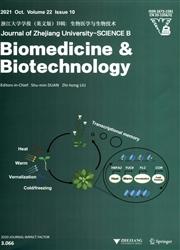转录组分析揭示了弓形虫感染诱导细胞凋亡的多种途径
IF 4.7
3区 生物学
Q1 BIOCHEMISTRY & MOLECULAR BIOLOGY
引用次数: 5
摘要
刚地弓形虫是一种世界性的寄生虫,它可以感染几乎所有种类的哺乳动物,并在免疫功能低下的患者中引起致命的弓形虫病。细胞凋亡是宿主细胞清除病原体和维持机体稳态的主要策略之一,但弓形虫诱导细胞凋亡的机制尚不清楚。为了探讨弓形虫对细胞凋亡的影响,我们对感染或未感染弓形虫的Vero细胞进行了细胞凋亡检测并进行了双RNA测序(RNA-seq)。通过高通量Illumina测序和生物信息学分析,我们发现促凋亡基因如DNA损伤诱导转录物3 (DDIT3)、生长阻滞和DNA损伤诱导α (GADD45A)、CASP3 (CASP3)和高温要求蛋白酶A2 (HtrA2)上调,抗凋亡基因如聚二磷酸腺苷(ADP)核糖聚合酶家族成员3 (PARP3)、b细胞淋巴瘤2 (Bcl-2)、杆状病毒凋亡抑制蛋白(IAP)重复序列5 (BIRC5)表达下调。此外,肿瘤坏死因子(TNF)受体相关因子1 (TRAF1)、TRAF2、TNF受体超家族成员10b (TNFRSF10b)、失能同源物2 (DAB2)相互作用蛋白(DAB2IP)和肌醇1,4,5-三磷酸受体3 (ITPR3)富集于TNF、TNF相关凋亡诱导配体(TRAIL)和内质网(ER)应激途径的上游。而trail -受体2 (TRAIL-R2)被认为是弓形虫影响的一个重要的膜受体,以前没有被考虑过。综上所述,弓形虫RH菌株可通过上述多种途径促进和介导Vero细胞凋亡。我们的发现通过提供有关细胞凋亡机制的新见解,提高了对弓形虫感染过程的理解。本文章由计算机程序翻译,如有差异,请以英文原文为准。
Toxoplasma gondii infection induces cell apoptosis via multiple pathways revealed by transcriptome analysis
Toxoplasma gondii is a worldwide parasite that can infect almost all kinds of mammals and cause fatal toxoplasmosis in immunocompromised patients. Apoptosis is one of the principal strategies of host cells to clear pathogens and maintain organismal homeostasis, but the mechanism of cell apoptosis induced by T. gondii remains obscure. To explore the apoptosis influenced by T. gondii, Vero cells infected or uninfected with the parasite were subjected to apoptosis detection and subsequent dual RNA sequencing (RNA-seq). Using high-throughput Illumina sequencing and bioinformatics analysis, we found that pro-apoptosis genes such as DNA damage-inducible transcript 3 (DDIT3), growth arrest and DNA damage-inducible α (GADD45A), caspase-3 (CASP3), and high-temperature requirement protease A2 (HtrA2) were upregulated, and anti-apoptosis genes such as poly(adenosine diphosphate (ADP)-ribose) polymerase family member 3 (PARP3), B-cell lymphoma 2 (Bcl-2), and baculoviral inhibitor of apoptosis protein (IAP) repeat containing 5 (BIRC5) were downregulated. Besides, tumor necrosis factor (TNF) receptor-associated factor 1 (TRAF1), TRAF2, TNF receptor superfamily member 10b (TNFRSF10b), disabled homolog 2 (DAB2)-interacting protein (DAB2IP), and inositol 1,4,5-trisphosphate receptor type 3 (ITPR3) were enriched in the upstream of TNF, TNF-related apoptosis-inducing ligand (TRAIL), and endoplasmic reticulum (ER) stress pathways, and TRAIL-receptor 2 (TRAIL-R2) was regarded as an important membrane receptor influenced by T. gondii that had not been previously considered. In conclusion, the T. gondii RH strain could promote and mediate apoptosis through multiple pathways mentioned above in Vero cells. Our findings improve the understanding of the T. gondii infection process through providing new insights into the related cellular apoptosis mechanisms.
求助全文
通过发布文献求助,成功后即可免费获取论文全文。
去求助
来源期刊

Journal of Zhejiang University SCIENCE B
生物-生化与分子生物学
CiteScore
8.70
自引率
13.70%
发文量
2125
审稿时长
3.0 months
期刊介绍:
Journal of Zheijang University SCIENCE B - Biomedicine & Biotechnology is an international journal that aims to present the latest development and achievements in scientific research in China and abroad to the world’s scientific community.
JZUS-B covers research in Biomedicine and Biotechnology and Biochemistry and topics related to life science subjects, such as Plant and Animal Sciences, Environment and Resource etc.
 求助内容:
求助内容: 应助结果提醒方式:
应助结果提醒方式:


